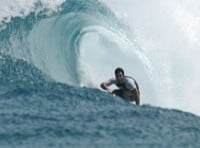
TECHNOLOGY SAVES CHAMPION SURFER FROM SHARK ATTACK

People and endangered species fight back
- Dateline
- 19 August 2008
Surfing was suspended for two hours due to a shark scare during the final of the Billabong Pro surfing championship in Jeffrey’s Bay, South Africa, yesterday.
Organizers were alerted to the presence of a Great White shark thanks to a recently installed satellite-based tracking and warning system. Three-time Foster’s ASP Men’s World Tour champion, Mick Fanning, surprised judges by suddenly catching a rather mediocre wave to shore.
“My Shark Buddy ankle bracelet started vibrating. I had to get out of the water fast!” said Mick during the recess. Judges agreed to amend the contest rules following the unexpected and unprecedented disruption, without penalizing the surfer.
It is expected that Shark Buddy protection will become the norm for all cold water contests. The alert system was developed by SharkTek, who will roll out a global network similar to the international Tsunami warning system.
SharkTek is already tracking endangered sharks and Indian tigers as part of a research program which seeks to protect endangered animals. The system uses networked RFID sensors and marine communication buoys that are independently powered by wave energy.
The business applications of this technology are profound and are now being proved in the most hostile of environments.
ANALYSIS >> SYNTHESIS: How this scenario came to be
2002: Wireless Innovation Award
Lotek Wireless wins the Canada Export Award for their innovative Wildlife tracking technology. Their expertise covers a wide range of activities “from protecting endangered elephants in Africa to monitoring the safe passage of salmon through hydroelectric dams on the Columbia River.” Other species being tracked with Lotek devices include tuna, turtles, whales, crabs, penguins and seals.
June 2006: International co-operation agreements>
The application of technology in international warning systems is not new. On 28 June 2006 UNESCO announces that the Tsunami warning system covering the Indian Ocean region is fully operational. This follows the devastating tsunami which killed 200,000 people in December of 2004. According to a BBC report “The Pacific region has had a system for 40 years and others are planned for the Atlantic, Mediterranean and Caribbean.”
Three companies from Australia, Canada and South Africa sign a memorandum of understanding to start developing a shark warning system that they plan to roll out internationally.
August 2006: Life-saver loses foot in shark attack>
Following sensational media reports some people call for larger sharks to be selectively hunted and killed. This is a short-sighted and destructive solution to a problem that can be solved using developments in technology. Ideally we would want to live in a world where technology helps solve our problems and finds ways to promote co-existence with dangerous forms of biodiversity like Great White sharks. Just because they are dangerous doesn’t mean they need to be eradicated or hunted to extinction. All animals are part of complex interrelated ecological networks where the roles and symbiotic relationships of individual members are often not well understood.
Migration patterns of migratory birds have been tracked across record distances over the Pacific Ocean. The Sooty Shearwater’s 200-day flight across 64,000 km was tracked by electronic tags weighing as little as 6 grams.
Communication technology is becoming more networked and intelligent. RFID (radio frequency identification) technology is well established as an inventory management tool. These technologies rapidly diffuse into other markets to find niche business applications.
January 2007: Satellite-based research program launched>
Several Great White sharks are tagged in a research program supported by academics and the commercial cage-diving industry. SharkTek secures sponsorship from the White Shark Trust . Satellite aided tracking techniques allow migration patterns, mating habits and eating patterns to be studied.
October 2007: SharkTek launches e-SharkNet
SharkTek launches its environmentally friendly e-SharkNet. The system is successfully tested and implemented in Australia. The system uses several buoys anchored to the seabed to form an extensive grid pattern of sensors and networked communication technology. The buoys each have built-in audible alarms which alert swimmers in the immediate vicinity to the presence of a tagged shark. The wireless network activates a beach-based public address system, sirens and flashing lights. The communication protocol is encrypted to avoid false alarms.
The devices are powered by wave energy – using oscillating water columns that drive mini-turbines to keep the batteries charged.
April 2008: e-SharkNet ‘Buddies’ launched
The company produces and markets personal shark protection apparel devices (affectionately known as ‘Shark Buddies’). These highly fashionable wrist, waist and ankle bands have vibrating sections that are activated when the encoded shark warning signals are detected. SharkTek boosts the integrity of the early warning system by integrating the satellite tracking program into the floating sensor-based communication network.
Links to related stories
- Call for Great White sharks to be selectively killed - Independent Online 19 August 2006
- Hi-tech tags record epic bird migration - BBC News Online 8 August 2006
- Alternative shark protection technology - Independent Online 19 August 2006
- International tsunami warning system - BBC News Online 28 June 2006
- Review of technologies based on Wave Energy - Carbon Trust 2006
- MindBullet: THE EMBARRASSMENT OF THE WORLD'S LAST SMART CARD USER (Dateline: 1 January 2010, Published: 21 October 2004)
Warning: Hazardous thinking at work
Despite appearances to the contrary, Futureworld cannot and does not predict the future. Our Mindbullets scenarios are fictitious and designed purely to explore possible futures, challenge and stimulate strategic thinking. Use these at your own risk. Any reference to actual people, entities or events is entirely allegorical. Copyright Futureworld International Limited. Reproduction or distribution permitted only with recognition of Copyright and the inclusion of this disclaimer.